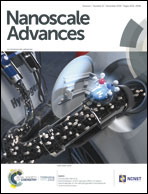Zirconia nanocomposites with carbon and iron(iii) oxide for voltammetric detection of sub-nanomolar levels of methyl parathion†
Abstract
This study reports the synthesis of zirconia nanoparticles loaded on various carbon substrates, namely, reduced graphene oxide (Zr-r-GO), carbon nanotubes (Zr-CNT), and activated carbon (Zr-AC). In addition, a composite of zirconia–iron mixed oxide loaded on activated carbon (FeZr-AC) was also synthesized. The materials were characterized using SEM-EDX, HRTEM, FTIR, Raman spectroscopy, TGA and XRD. The FeZr-AC sample was found to have a nanorod like morphology. The samples were evaluated for their sensing potential towards methyl parathion (MP) using differential pulse voltammetry in a range of 0.0 V to −0.9 V (vs. Ag/AgCl) by drop casting on a glassy carbon electrode (GCE). All the modified GCEs best operated at a working potential of 0.4–0.9 V vs. Ag/AgCl/Cl−. FeZr-AC was found have the best limit of detection followed by Zr-AC, Zr-CNT and Zr-r-GO with their detection limits being 1.7 × 10−9 M, 17.2 ×10−9 M, 243.3 × 10−9 M and 534.0 × 10−9 M respectively. These materials were then used to detect MP in spiked sewage samples and showed good recoveries.

- This article is part of the themed collection: Gas sensing


 Please wait while we load your content...
Please wait while we load your content...